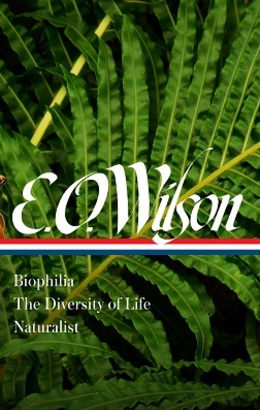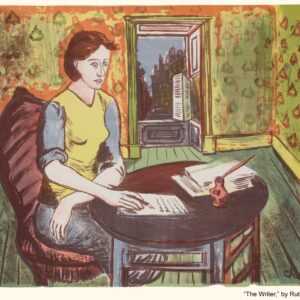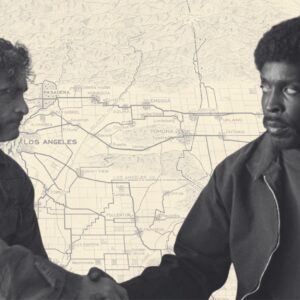
On the Accidental Career of E.O. Wilson
David Quammen Considers the Life of a Naturalist
Edward O. Wilson was born on June 10, 1929, in Birmingham, Alabama; spent much of his boyhood in the piney forests and bayous and swamps of the Southeast; found his way to Harvard to do a doctorate on ants; and rose to become one of the most famous, celebrated, and controversial biologists of the late 20th and early 21st centuries. It has been a long and serpentine path. He recounts portions of this improbable journey in some of his writings, but nowhere more pithily than in a single sentence from his 1994 autobiography, Naturalist: “I am blind in one eye and cannot hear high-frequency sounds; therefore I am an entomologist.”
The blinding, which he has described as “a fortuitous constriction of physiological ability,” occurred when he was seven. He was spending a summer on the Florida panhandle coast, boarded out among strangers as his parents drifted toward divorce, and doing the sorts of things that a solitary child who finds solace and fascination in nature would do. Wandering the strand. Wading in the shallows. Gazing at stingrays. That particular day he was fishing from a dock. A small spiny animal called a pinfish touched his bait, and he struck back, too forcefully. “It flew out of the water and into my face. One of its spines pierced the pupil of my right eye.” Characteristically for Wilson, when he tells this story he identifies the pinfish to species: Lagodon rhomboides. His eye never healed well, the pupil clouded over, and months later he squirmed through an old-fashioned ether-drip anaesthetization so that a surgeon could remove his lens. For years afterward, the smell of ether made him nauseous.
But he still had the left eye and, fortunately for him, its short-range acuity was exceptionally high. He could count tiny hairs on the thorax of a very small insect—which is how, sometimes, you tell one species from another—though he couldn’t spot the brown bird amid the brown limbs in a distant tree. Sometime during adolescence, for reasons that may have involved genetic predisposition (anyway, not angling), Wilson also lost most of his hearing in the high registers. So he couldn’t detect the brown bird by its song either. This is how lives are shaped. He focused his natural history enthusiasms at relatively close range, developing a passionate interest in butterflies, which could be caught in a cheesecloth net, killed and mounted, their markings studied in fine detail. He also, less conventionally for a nature boy, became fascinated with ants. They were available but mysterious. You could find them by ripping bark off a dead tree, and then they would scurry away—to go where, do what? You could read about them in National Geographic. Ants could be captured live, their tunneling behavior observed in a jar of sand. Let me repeat that, because it’s important: their behavior observed. Not many years after the eye injury, precociously early in fact, his love of nature began florescing into another dimension: an aspiration toward science.
This is a step not every ten-year-old lepidopterist takes. Little Ed got hold of a classic text, R.E. Snodgrass’s Principles of Insect Morphology, and pored over it with half-comprehending reverence. He wanted to learn exactly what the title advertised: principles, not just the names of pretty creatures. He wanted to pose questions, seek reasons, and discern patterns. Eventually he arrived at what, with adolescent seriousness and no small bit of ambition, he saw as a decision point. He should chart his career in entomology. “The time had come to select a group of insects on which I could become a world authority.” He was 16 years old, still one year from entering the University of Alabama as a freshman.
As Wilson tells this story on himself, in Naturalist, there were several well-calculated considerations. Butterflies were out: too well-known and much studied by other scientists. Flies were more enticing—true flies, the order Diptera—especially the so-called long-legged flies, known as dolichopodids to the cognoscenti (of which teenage Wilson was one), a diverse family of delicate, stilt-walking forms, many of them decorated with a metallic blue-green sheen, like a prized 1958 Chevy. But to collect, mount, and study flies, Wilson would need certain tools, including a very special sort of long, black insect pin, for mounting and drying and labeling specimens. Those pins were made mainly in Czechoslovakia. But it was 1945 now, just after the Second World War, and Soviet-occupied Czechoslovakia wasn’t exporting insect pins.
He wanted to pose questions, seek reasons, and discern patterns.
Ants, on the other hand, being wingless (except the sexual individuals, during their brief mating flights) and therefore slightly less fragile, could be pickled and stored in little glass bottles of alcohol. Rubbing alcohol and small vials for holding medicinal potions—you could get these at a drugstore in Decatur, Alabama, where Wilson was finishing high school. “I quickly hit upon ants.”
Although he makes it sound almost larkish or random, that choice was vastly consequential. I invite you to ponder how the intellectual landscape of modern biology might be different today—notably, the ferment of ideas about behavior among social animals, from ants and termites to naked mole-rats, baboons, and humans, and the evolutionary origins of such behavior, the field sometimes known as sociobiology—if young Ed Wilson had committed his life to the study of butterflies.
*
There’s another factor that made this one-eyed boy exceptional as he grew into a mature scientist, a man with broad intellectual scope as well as a keen focus on ants, a fearless theorist as well as an eminent taxonomist, restless to detect patterns in the scientific data and push the boundaries of conventional thinking: he could write.
Wilson was, and remained, very good with the English language. I don’t favor overzealous exercises in hindsight to see the shape of the oak revealed in the curves of the acorn, but in this case there is one acorn’s curve worth noting. It’s another little datum from his childhood, reported in Naturalist. Rummaging backward through family papers as he wrote that book, Wilson found an old letter from his fifth-grade teacher to his parents, sent in 1940, which said: “Ed has genuine writing ability, and when he combines this with his great knowledge of insects, he produces fine results.” That’s probably far more prophetic than anything your fifth-grade teacher or mine ever said about us.
Wilson at his best is a writer of great skill and aplomb. His books for the general public, including the three collected in this volume (and more that will appear in a future Library of America Wilson volume), flow with high narrative skill and expository eloquence, offering many passages of keen character portrait, self-deprecating humor, emotional impact, and elegant description. He has a voice and he knows how to use it. He has the chops. For that reason, reading Wilson is more than just informative, stimulating, often provocative, sometimes aggravating, and always challenging to comfortable assumptions. It’s also a literary pleasure.
This skill was first broadly recognized in 1979, when his incendiary book On Human Nature received the Pulitzer Prize for General Non-Fiction. (By nice coincidence, the prize for poetry that year went to another writer who had been a one-eyed boy closely observing nature in the South, Robert Penn Warren. It was Warren’s third of three Pulitzers and Wilson’s first of two, but alas they never had occasion to compare notes.) On Human Nature was the final book in a trilogy, on the ideas and applications of sociobiology, that Wilson himself hadn’t consciously seen as trilobate until he had almost finished writing. It was also the crescendo of what science historians have called “the sociobiology controversy,” of which Wilson was chief provocateur and central figure. His work in that vein will constitute much of Library of America’s second Wilson volume, but it bears mentioning here as an important phase in his evolution as a scientist, a public figure, and a writer. Among the most vivid accounts of that controversy—persuasive and lucid, though it can’t be called objective—is Wilson’s own, in the later chapters of Naturalist.
Sociobiology is the study of the ecological, evolutionary, and genetic dimensions of social behavior among animals, including humans. Wilson came to it naturally from his study of social insects, publishing an ambitious overview of ants, termites, wasps, and bees as The Insect Societies in 1971. In the last chapter of that book, he wrote: “When the same parameters and quantitative theory are used to analyze both termite colonies and troops of rhesus macaques, we will have a unified science of sociobiology.” He set to work toward advancing that unification himself. Four years later, in the first chapter of his tome Sociobiology, which is subtitled The New Synthesis, he picked up where The Insect Societies left off, noting that the task of sociobiology is to understand forms of social behavior with the help of Darwinian logic, and adding: “For the present it focuses on animal societies, their population structure, castes, and communication, together with all of the physiology underlying the social adaptations.” Then he dropped a pebble in that clear pool: “But the discipline is also concerned with the social behavior of early man and the adaptive features of organization in the more primitive contemporary human societies.”
Reading Wilson is more than just informative, stimulating, often provocative, sometimes aggravating, and always challenging to comfortable assumptions. It’s also a literary pleasure.
There followed 25 chapters, more than 500 double-column pages, describing a vast body of work by various researchers on the principles of this science and their application to many kinds of animals, many differing forms and degrees of sociality. The tour d’horizon proceeded from ant and termite societies to schooling among fish, territorial competition among frogs, “mob” assemblages and dominance hierarchies among wallabies, pride formation among lions, troop structure among ringtail lemurs, and the intricate forms of transactional cooperation that Jane Goodall and others had observed among chimpanzees. In the final chapter, as he had done with The Insect Societies, Wilson bridged to the next big idea: “Let us now consider man in the free spirit of natural history, as though we were zoologists from another planet completing a catalog of social species on Earth.” Altruism, bonding, division of labor, vocal communication, tribalism, ritual, even religion: Was it possible that these unusual forms of behavior originated from factors that included (note: he didn’t say were limited to) natural selection acting on genetic variation within human populations? Flash: the fat hit the fire.
More on all that in volume two. Suffice it here to say that a loose collection of excitable scientists and other academics in Boston, including several of Wilson’s Harvard colleagues, constituted themselves into what they called the Sociobiology Study Group, devoted to denouncing Wilson’s ideas and writings as well as studying them, and that if the 1979 Pulitzer judges had viewed On Human Nature through the same lens that the Sociobiology Study Group did, that book would never have received the prize. But it did, and even as it did, Wilson was pivoting toward the next phase of his extraordinary career.
*
Again a hint of the new interests appeared in late pages of one book, heralding the next. In the last chapter of On Human Nature he postulated the existence and evolutionary origin of certain “cardinal values” in the collective human population. One of those values is the very survival of the human species, the human genetic line. We care, more than members of Tyrannosaurus rex could have consciously cared, about our own collective continuation. Another value is the diversity of the human gene pool. We sense (though certain politicians tend to forget) that we are well served by our own variousness. A third cardinal value, Wilson wrote, is universal human rights. We may disagree about just what they are, but the concept is deeply ingrained. Beyond these three, he wrote, are some secondary values that may also have arisen and persisted in part because they have helped our survival and reproductive success: the thrill of discovery, triumph in battle, satisfaction from acts of generosity, ethnic pride, and finally but not least “the secure biophilic pleasure from the nearness of animals and growing plants.” As far as I can tell, that was Wilson’s first allusion to what he would soon develop as the concept of biophilia.
The word itself wasn’t his invention. It could be traced back to writings of the social psychologist Erich Fromm, from the 1960s and early 1970s, who defined biophilia as “the passionate love of life and of all that is alive.” Fromm’s meaning was a bit different from Wilson’s idea, more a matter of clinging to life and furthering growth than an innate inclination to affiliate oneself with other living forms. “The tendency to preserve life and fight against death,” Fromm wrote, in 1964, “is the most elementary form of the biophilous orientation, and is common to all living substance.” Wilson may have been unaware of Fromm’s prior use and put together this portmanteau word independently, as his recollection in Naturalist suggests. Anyway, in early 1979 he introduced it with a new meaning within a new context—more evolutionary than Fromm’s—by way of a fragment of essay published in The New York Times Book Review. That fragment, somewhat oddly, served as text of an advertisement for Harvard University Press. “Capital Ideas from People Who Publish with Harvard” was the ad’s headline, with Wilson’s capital idea as exemplar: “Our deepest needs stem from ancient and still poorly understood biological adaptations. Among them is biophilia, the rich, natural pleasure that comes from being surrounded by living organisms, not just other human beings but a diversity of plants and animals that live in gardens and woodlots, in zoos, around the home, and in the wilderness.” True to promise, Harvard University Press published this capital idea five years later in his book Biophilia.
Something important had happened, in the meantime, to Wilson’s scientific focus and personal sense of imperatives: his long-standing devotion to biological diversity, and his concern over the rate of species extinctions, population declines, and habitat losses on Earth, due to human actions, had converged to a critical point.
*
Human destruction of biological diversity was nothing new, in the early 1980s, either to Wilson or to other biologists and attentive nonscientists. The British ecologist Charles Elton had published a lucidly detailed warning, back in 1958, in his book The Ecology of Invasions by Animals and Plants. Elton focused on the impacts of invasive species, and of chemically enforced homogeneity, not on the other foremost diversity-reducing factors, such as habitat loss, habitat fragmentation, and unsustainable “harvest” by humans; but he called out the net effects. “On the exploited lands of the world,” Elton wrote,
we see a decrease in richness and variety of species: monocultures with rigid spraying programmes, pastures of pure grass populations, pure stands of trees, the replacement of stratified and mature deciduous woods by quick-growing conifers with their relatively barren structure and poor inhabitants, the cleaning up of waste patches, the hormone spraying of roadsides, and the planting of exotic species many of which may literally be quite sterile of animal life—at first. We might sum up this stream of events in the words of Isaiah: “Woe unto them that join house to house, that lay field to field, till there be no place, that they may be placed alone in the midst of the earth!”
Others, biologists and writers, followed with similar warnings during the next couple of decades: Peter Matthiessen (Wildlife in America, 1959), Rachel Carson (Silent Spring, 1962), James Greenway (Extinct and Vanishing Birds of the World, especially the second edition, 1967), Norman Myers (The Sinking Ark, 1979), plus various works of Daniel Janzen, Alwyn Gentry, Peter Raven, Paul and Anne Ehrlich, Robert Michael Pyle, and many more.
Wilson, by his own account, came abashedly late to this cause, in about 1980, moving only then from a state of quiet discomfort at what he had seen since his Alabama boyhood— rampant destruction of habitats, loss of diversity—to a state of abhorrent alarm. That was just after he read Norman Myers’s systematic estimates of the rate at which tropical rainforests were being cut and burned, and at a time when Wilson’s friend Peter Raven, an eminent botanist, was chairing a National Research Council study of the problem and its possible remedies. Wilson tells this story in Naturalist too. Raven’s was a leading voice, urging field biologists to fight against the obliteration of biological diversity, the very matter they studied. Wilson called Raven and said: Count me in.
“Our deepest needs stem from ancient and still poorly understood biological adaptations. Among them is biophilia, the rich, natural pleasure that comes from being surrounded by living organisms.”
The shift from sociobiology and its principles to biological diversity and its preservation was a panning movement along a spectrum of issues for Wilson, not a vault over some intellectual wall. The concept of biophilia, for instance, like the concept of altruism as a heritable tendency, involves speculation about how human behavioral motifs have been shaped, partly, by natural selection over evolutionary stretches of time, acting upon genetic variation.
Still, there was something distinctly different. Biophilia the book, even more than biophilia the idea, marked a new stage in Wilson’s career and his reputation. He revealed himself as a graceful writer and a compelling memoirist who could mix storytelling with big ideas, delivering a potpourri of scientific, philosophic, and narrative material in a very human, companionable voice. He drew on old journals from his field travels, especially to Suriname in 1961—a respite from Harvard, after his Melanesian journey and before his partnership with Robert MacArthur, a mathematical ecologist with whom he coauthored his first important, very technical book. (That was The Theory of Island Biogeography, 1967.) The anecdotes and observations from Suriname, the central Amazon, New Guinea, and elsewhere served him, like shovels, as he dug toward deeper insights.
And he didn’t confine his attention to ants. Here in the Suriname forest was a three-toed sloth, upon which lived tiny moths of the species Cryptoses choloepi, innocuous passengers amid the mammal’s fur. When the sloth climbed down from the treetops to the forest floor to defecate, a weekly routine, female moths would emerge from its fur, flying out (or jumping off?) to lay their eggs on its fresh, warm dung, which would nourish the hatchling caterpillars from those eggs. When the caterpillars grew big and metamorphosed into adults, they would fly back into the canopy, find another sloth to ride, and the cycle would repeat. By living directly and patiently on the sloths, rather than flapping around in the understory looking for sloth dung, the females of C. choloepi saved themselves energy while ensuring that their young would get immediate access to choice food amid a very competitive forest.
“The study of every kind of organism matters,” Wilson wrote, because “nothing in the whole system makes sense until the natural history of the constituent species becomes known.” (This was an echo, probably conscious, of the Russian-American geneticist Theodosius Dobzhansky’s famous dictum: “Nothing in biology makes sense except in the light of evolution.”) That is, the science of ecology must be built by beginning from individual life histories. Wilson’s statement was hyperbolic, maybe, but hyperbole containing a truth to which he has remained committed: details count. Work from the ground up. Even the big principles of theoretical ecology—and Wilson has ever been hungry to find big principles—cannot be extracted except from the assemblage of multifarious data about how and where particular creatures live. Robert MacArthur, the brilliant mathematical modeler, did his dissertation on warblers.
Charles Darwin devoted eight years to barnacle taxonomy. Wilson knew ants, first of all for their own sake. That’s why he later titled his autobiography Naturalist, not Theorist.
The other change that manifested in Biophilia was Wilson’s awakened concern over the global trend of biodiversity loss. The whole book, in a sense, was an argument that we humans need and we want—more deeply than we even know, as deep as our genomes, shaped by millions of years of evolution—to live surrounded by other living creatures of all sorts, wriggling, furry, large, tiny, brown, yellow, green. In its penultimate chapter, titled “The Conservation Ethic” (his variant on Aldo Leopold’s “The Land Ethic”), Wilson places human-caused destruction of biological diversity second only below nuclear war on the list of regrettable blunders that humans might inflict upon the planet and their own descendants. He judges it worse than “energy depletion, economic collapse, conventional war, or even the expansion of totalitarian governments,” as an irreparable tragedy. (Interestingly, he doesn’t mention climate change, or even “global warming,” on this list, which suggests how little that problem occupied attentions at the time.
Nowadays he would cite climate change as a rising contributor to the losses of biological diversity—among corals and other marine species, for instance.) What’s worse than everything except nuclear Armageddon? “The one process now going on that will take millions of years to correct is the loss of genetic and species diversity by the destruction of natural habitats. This is the folly our descendants are least likely to forgive us.” Those words, published in the slim, anomalous Biophilia in 1984, defined much of his working agenda for the next 35 years. Most immediately, they led to his encyclopedic but dazzling 1992 book, The Diversity of Life, also included here. Beyond that, they guided him toward more wild places, more efforts of persuasion to save those wild places, more scientific studies, more tireless acts of hope and determination, more explosions of boyish wonderment, and (best for us) more literary projects, as he moved across planet Earth, with his forceps, and his collecting bottles, and his hand lens, and his eye wide open.
__________________________________

From E.O. Willson: Biophilia, The Diversity of Life, Naturalist, courtesy Library of America. Copyright David Quammen, 2021.
David Quammen
David Quammen’s sixteen previous books include The Tangled Tree, The Song of the Dodo, The Reluctant Mr. Darwin, and Spillover, a finalist for the National Book Critics Circle Award and recipient of the Premio Letterario Merck, in Rome. He has written for The New Yorker, Harper’s Magazine, The Atlantic, National Geographic, and Outside, among other magazines, and is a three-time winner of the National Magazine Award. Quammen shares a home in Bozeman, Montana, with his wife, Betsy Gaines Quammen, author of American Zion, and with two Russian wolfhounds, a cross-eyed cat, and a rescue python. Visit him at DavidQuammen.com.












